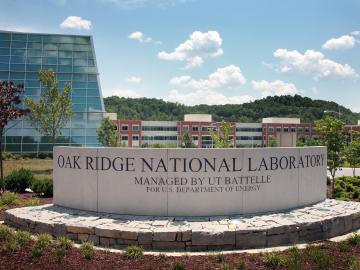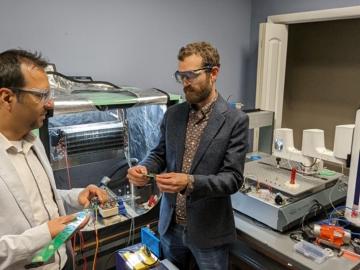
Filter News
Area of Research
- Advanced Manufacturing (2)
- Biology and Environment (30)
- Computational Engineering (1)
- Energy Science (28)
- Fuel Cycle Science and Technology (1)
- Fusion and Fission (17)
- Fusion Energy (1)
- Isotope Development and Production (1)
- Isotopes (6)
- Materials (38)
- Materials for Computing (5)
- National Security (11)
- Neutron Science (9)
- Nuclear Science and Technology (11)
- Supercomputing (19)
News Type
News Topics
- (-) Biomedical (30)
- (-) Chemical Sciences (44)
- (-) Clean Water (9)
- (-) Coronavirus (23)
- (-) Machine Learning (23)
- (-) Microscopy (28)
- (-) Nuclear Energy (44)
- (-) Space Exploration (3)
- 3-D Printing/Advanced Manufacturing (61)
- Advanced Reactors (14)
- Artificial Intelligence (44)
- Big Data (20)
- Bioenergy (48)
- Biology (53)
- Biotechnology (17)
- Buildings (25)
- Composites (15)
- Computer Science (77)
- Critical Materials (13)
- Cybersecurity (23)
- Education (3)
- Element Discovery (1)
- Energy Storage (56)
- Environment (78)
- Exascale Computing (16)
- Fossil Energy (1)
- Frontier (19)
- Fusion (26)
- Grid (23)
- High-Performance Computing (43)
- Hydropower (2)
- Isotopes (33)
- ITER (3)
- Materials (69)
- Materials Science (71)
- Mathematics (5)
- Mercury (6)
- Microelectronics (1)
- Molten Salt (3)
- Nanotechnology (35)
- National Security (35)
- Neutron Science (64)
- Partnerships (33)
- Physics (42)
- Polymers (18)
- Quantum Computing (14)
- Quantum Science (36)
- Security (19)
- Simulation (18)
- Statistics (1)
- Summit (24)
- Transportation (38)
Media Contacts

A collection of seven technologies for lithium recovery developed by scientists from ORNL has been licensed to Element3, a Texas-based company focused on extracting lithium from wastewater produced by oil and gas production.

Two different teams that included Oak Ridge National Laboratory employees were honored Feb. 20 with Secretary’s Honor Achievement Awards from the Department of Energy. This is DOE's highest form of employee recognition.

Chelsea Chen, a polymer physicist at ORNL, is studying ion transport in solid electrolytes that could help electric vehicle battery charges last longer.

In a win for chemistry, inventors at ORNL have designed a closed-loop path for synthesizing an exceptionally tough carbon-fiber-reinforced polymer, or CFRP, and later recovering all of its starting materials.

Four ORNL teams and one researcher were recognized for excellence in technology transfer and technology transfer innovation.

Louise Stevenson uses her expertise as an environmental toxicologist to evaluate the effects of stressors such as chemicals and other contaminants on aquatic systems.

Corning uses neutron scattering to study the stability of different types of glass. Recently, researchers for the company have found that understanding the stability of the rings of atoms in glass materials can help predict the performance of glass products.


Caldera Holding, the owner and developer of Missouri’s Pea Ridge iron mine, has entered a nonexclusive research and development licensing agreement with ORNL to apply a membrane solvent extraction technique, or MSX, developed by ORNL researchers to mined ores.

Guided by machine learning, chemists at ORNL designed a record-setting carbonaceous supercapacitor material that stores four times more energy than the best commercial material.


